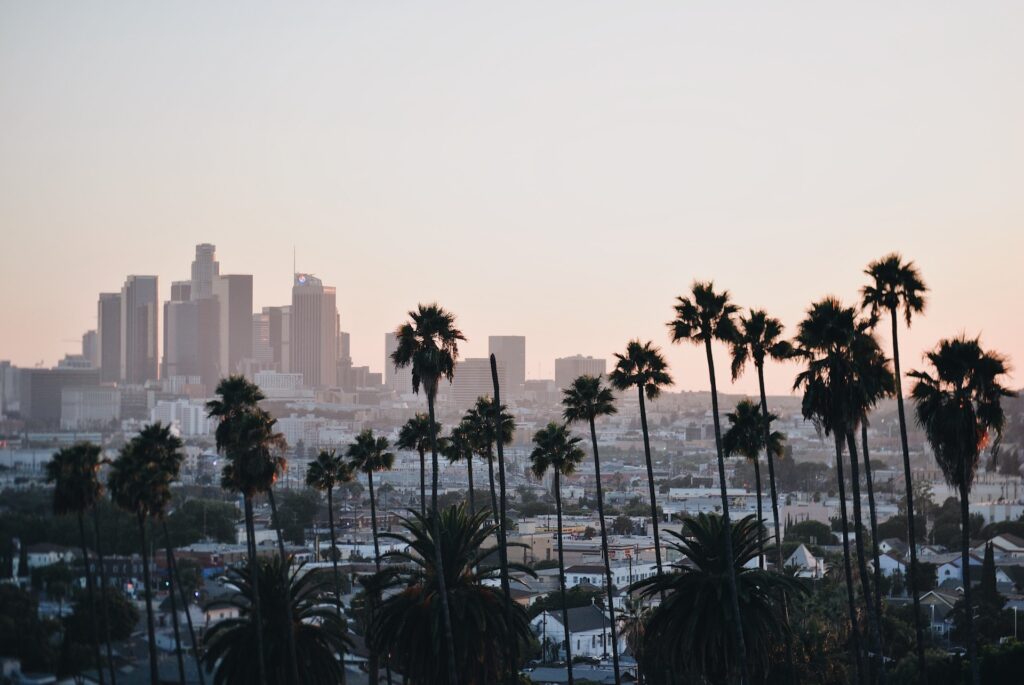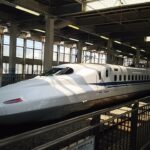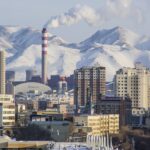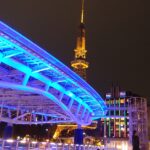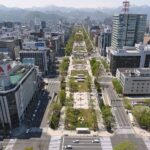Los Angeles, a sprawling Southern California city, offers a variety of public transportation options. The Los Angeles County Metropolitan Transportation Authority (Metro) is in charge of running the public transportation system, which consists of buses, light rail, and subways. The Metro Rail system, which serves around 350,000 passengers daily, comprises six lines that cover different parts of the city, including the Red Line subway and the Green Line, which serves the southern suburbs. Additionally, the city’s bus service operates over 170 routes, connecting various neighborhoods and providing access to significant city attractions. However, due to the vastness of Los Angeles, public transportation may not cover all areas extensively, and journey times can be lengthy.
Metro system in Los Angeles: basic information
The system includes six rail lines, two rapid transit subway lines (the Red and Purple lines), and four light rail lines (the Blue, Green, Gold, and Expo lines). The Metro also operates a comprehensive bus network, including Metro Local, Metro Rapid, and Metro Express buses. The rail and bus systems serve a population of approximately 12 million people spread over a 1,433-square-mile service area. The Metro system is designed to ease traffic congestion in the region and offers an alternative to the extensive freeway system in Los Angeles.
The lines of the Los Angeles subway system
The Red and Purple lines are the city’s primary subway lines, servicing the most densely populated areas of Los Angeles. Red Line, the first subway line in the city, stretches from Union Station in Downtown Los Angeles to North Hollywood. It serves 14 stations, including popular destinations like Hollywood and Vine, and Universal City/Studio City.
Purple Line, often considered an extension of the Red Line, runs from Union Station to Wilshire/Western Station. It has a total of eight stations, including key points of interest like the Civic Center/Grand Park and the Wilshire/Normandie. The Purple Line is currently undergoing an extension project, that is expected to add nine new stations, reaching the Veterans Affairs Hospital in Westwood upon completion.
The Light Rail Lines: Blue, Green, Gold, and Expo
- Blue Line, the oldest light rail line in the system, runs from Downtown Los Angeles to Downtown Long Beach, serving 22 stations.
- Green Line, unique for not passing through downtown, runs from Redondo Beach to Norwalk, connecting with the Blue Line at Willowbrook/Rosa Parks station.
- Gold Line, often regarded as the city’s scenic route, runs from East Los Angeles to Azusa, passing through Union Station. It boasts 27 stations, including popular stops at Chinatown, Little Tokyo/Arts District, and Highland Park.
- Expo Line, the newest addition to the system, runs from Downtown Los Angeles to Santa Monica. It serves 19 stations, providing access to key areas like the University of Southern California, Culver City, and Santa Monica Pier.
Combined, these six lines cover approximately 105 miles of track, making the Los Angeles Subway one of the largest public transportation systems in the United States. It provides a vital service to the residents and visitors of Los Angeles, offering a reliable and affordable alternative to driving.
The Los Angeles subway system is continually evolving, with additional lines and extensions being planned and constructed to better serve the growing city. It remains a testament to the city’s commitment to providing accessible public transportation, helping to alleviate traffic congestion, and reducing the city’s carbon footprint. The Los Angeles metro lines, with their extensive network and efficient service, are indeed a lifeline for this bustling city
Map of Los Angeles Metro 2023: Free Download in PDF
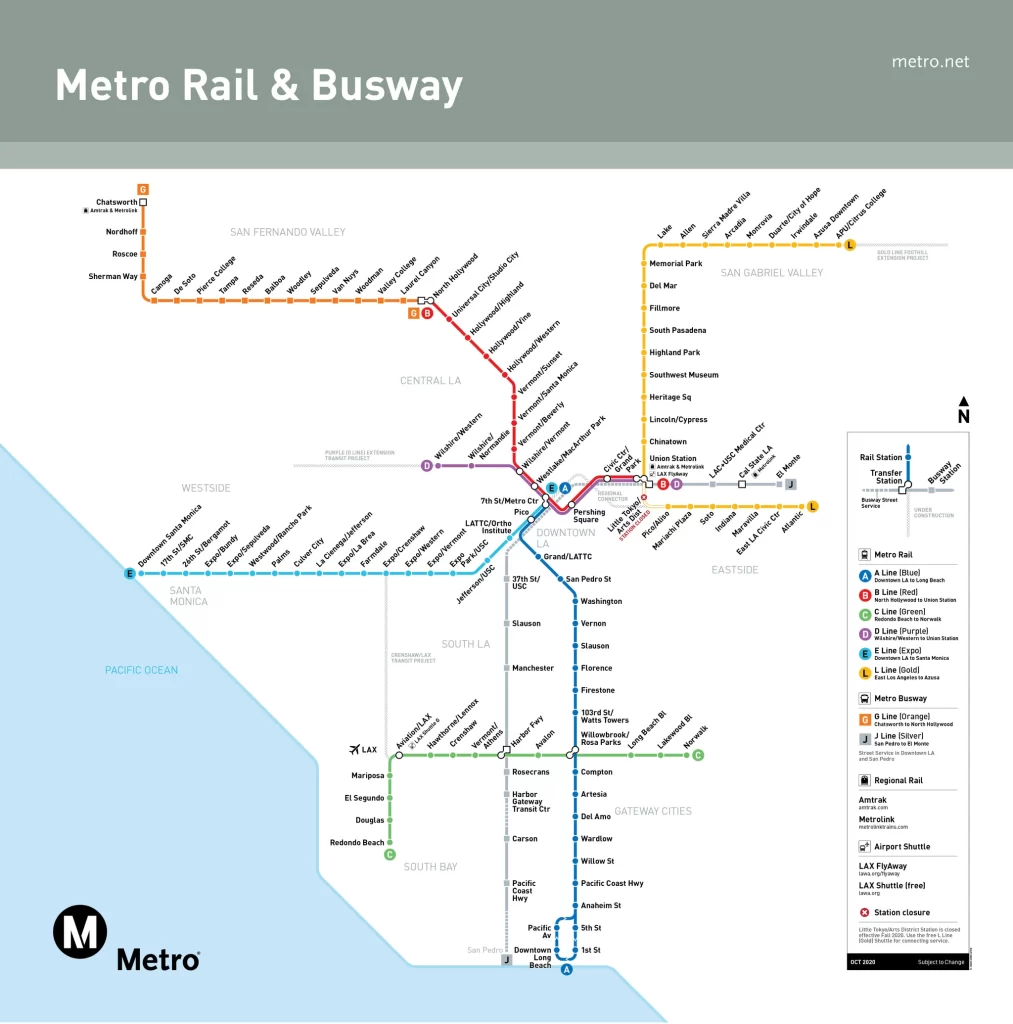
Click on the image and download the map of Los Angeles´s underground system for 2023
The Los Angeles Metro 2023 Map is available as a free PDF download, and it presents an all-encompassing perspective on the massive public transportation network that serves the city. Commuters may conveniently plan their excursions around the city with the help of this map, which allows them to immediately locate the station and route that is closest to their destination. The map provides specific information about each of the many lines, such as Metro Rail, Metro Bus, Metro Express, Metrolink, and Amtrak, in addition to notable attractions and landmarks in the area. In addition to that, it consists of a list of prices, schedules, and other essential details. Travelers will have an easier and more convenient time exploring the city if they have this user-friendly map.
Public transport tickets in Los Angeles: The Best types for travelers and actual prices
When preparing for a trip to Los Angeles, it is important to familiarize yourself with the various alternatives for purchasing tickets for the city’s public transit system. There are a number of distinct ticket categories, and the cost of admission will change depending on what kind of ticket you buy.
TAP card (Transit Access Pass)
Using a TAP card is the quickest, most hassle-free, and most practical method there is for paying for public transportation in Los Angeles. This reusable card costs $2 and may be filled with a variety of fare packages, including day passes, monthly passes, and even more options. TAP cards are accepted on all buses, trains, and light rail lines that make up the Los Angeles County Metro system.
TAP cards provide the ability to acquire day passes for a price of $7 each. For a period of one day, the day pass gives you access to an unlimited number of rides on all Metro bus lines, train lines, and light rail lines. You can also buy monthly passes for use on TAP cards, which give you access to unlimited trips on all Metro buses, trains, and light rail lines for a whole month. One hundred dollars is required for a monthly pass.
TAP cards can also be used to purchase single-ride tickets for public transportation. You are permitted to take one journey on any Metro bus, train, or light rail line with each of these tickets, which cost $1.75 each and may be purchased at any Metro station.
In addition, senior citizens, students, and individuals with disabilities can receive a reduced rate for their ticket purchases. TAP cards, which provide discounts on fares, are available to senior adults aged 65 and above for the low price of one dollar. TAP cards are also available to students aged 6 to 18 for a dollar each, allowing them to get discounted fares. Discounted fares are available to individuals with disabilities if they obtain a TAP card for the price of one dollar.
The purchase of a day pass for use with a TAP card is the most convenient choice for out-of-town visitors who will be in Los Angeles for a total of three days. For just $7, you can get a 24-hour pass that gives you access to an unlimited number of rides on all Metro bus lines, train lines, and light rail lines.
Summary of fares for public transport in Los Angeles
- TAP cards are the most convenient way to pay for public transit in Los Angeles. They cost $2 each and may be loaded with a number of different price packages.
- Day passes are available for a cost of $7 and give access to unlimited rides on all Metro bus, train, and light rail lines for a day.
- Monthly passes are available for a cost of $100 and give access to unlimited rides on all Metro buses, trains, and light rail lines for a month.
- Single-ride tickets are available for a cost of $1.75 and allow for one journey on any Metro bus, train, or light rail line.
Timetables & Schedules of the Los Angeles Metro System
The Metro system in Los Angeles operates from 5 a.m. to 12:30 a.m. from Monday through Friday, from 5 a.m. to 2 a.m. from Saturday through Sunday, and from 6 a.m. to 12:30 a.m. Just prior to the posted closing times, the final trains on each line depart from their respective terminals. The majority of lines operate at regular intervals of 12 minutes during peak hours, 15 minutes throughout the middle of the day, 20 minutes in the evening, and 30 minutes after midnight during the weekdays. On the weekends, the majority of lines operate around every 20 minutes during the day and approximately every 30 minutes in the evening. Holidays and other special occasions can be accommodated with the use of specialized timetables.
What Are Other Options For Public Transportation In Los Angeles?
Besides the Metro, Los Angeles has a number of other choices for public transportation. The Los Angeles Department of Transportation (LADOT) runs a number of bus routes, such as DASH, Commuter Express, and Cityride, that go to different parts of LA, such as downtown, Hollywood, and the San Fernando Valley. The Big Blue Bus is another choice. The city of Santa Monica is in charge of running it, and it travels to both Santa Monica and some areas of Los Angeles. There are also Amtrak trains that run between cities and Metrolink trains that run between Los Angeles and the areas around it. The city also has a bike share program for short trips, and there are many private companies that offer rideshare services.
how does public bus transportation work in Los Angeles
The Los Angeles County Metropolitan Transportation Authority, colloquially known as Metro, operates the primary public bus transportation system in Los Angeles. Metro’s bus system includes over 170 routes, covering an extensive area of 1,433 square miles. The system operates 24/7, making it a reliable mode of public transportation for the city’s residents and visitors.
The Metro bus system consists of two types of buses:
- Local buses, identifiable by their orange color and designated by a number, make frequent stops and serve every single bus stop along their route.
- Rapid buses, on the other hand, are red and stop only at major intersections, making them a faster option for long-distance travel.
Now, on to the most used bus lines in Los Angeles. These depend on a number of variables, such as the regions they serve and the frequency of their service. The 720 Wilshire Rapid Line, one of the most heavily used bus lines in the city, runs from Downtown LA through Koreatown, Mid-Wilshire, Beverly Hills, and ends in Santa Monica. This line is popular due to its extensive coverage of major LA areas and frequent service.
Next in line is the 20 Wilshire Local, which also runs from Downtown LA to Santa Monica but makes more stops than the 720 Rapid line. This line serves as a crucial connector for many commuters due to its comprehensive coverage of the city. The 754 Vermont Rapid Line, another commonly used route, runs from Vermont/Sunset Station to Athens in South LA. This line is particularly popular among hospital employees and students due to its proximity to several medical centers and schools.
The 2 Sunset Boulevard line is a lifeline for many Hollywood and Echo Park residents, providing frequent service from Downtown LA to Pacific Palisades via Sunset Boulevard. Lastly, the 4 Santa Monica Boulevard line connects Downtown LA with West LA, serving popular destinations like Hollywood and West Hollywood.
How do public intercity trains work in Los Angeles?
Amtrak, the National Railroad Passenger Corporation, also provides intercity train services. The primary Amtrak services in Los Angeles are:
- Pacific Surfliner operates from San Luis Obispo to San Diego, passing through Los Angeles and other major cities like Santa Barbara and Anaheim.
- Coast Starlight, on the other hand, offers a more long-distance service, running from Los Angeles to Seattle.
Los Angeles Union Station is the main railroad station in Los Angeles and the largest railroad passenger terminal in the Western United States. It’s also a major transportation hub for Southern California, serving almost 110,000 passengers a day. Now, let’s delve into the specifics of the most important train connections to other cities nearby.
- Los Angeles to San Diego: As mentioned, the Pacific Surfliner operates this route, making stops at significant cities like Anaheim and Oceanside. The journey takes approximately 2 hours and 45 minutes, and trains run multiple times a day.
- Los Angeles to Santa Barbara: This route is also serviced by the Pacific Surfliner. The journey takes around 2 hours and 40 minutes, offering stunning coastal views along the way.
- Los Angeles to San Francisco: This route is serviced by the Coast Starlight. The journey is longer, taking approximately 12 hours, but it’s an experience in itself, providing breathtaking views of the Pacific coastline and the Bay Area.
- Los Angeles to Las Vegas: While there isn’t a direct train from Los Angeles to Las Vegas, Amtrak offers a combination of train and bus services that make the journey possible. The trip begins on the Amtrak Southwest Chief to Barstow, followed by an Amtrak Thruway bus to Las Vegas.
- Los Angeles to Palm Springs: The Amtrak Sunset Limited and the Texas Eagle service this route three days a week. The journey takes roughly 2 hours and 30 minutes.
How To Get From Los Angeles International Airport (lax) To The City Center With Public Transport?
To get started, you will need to go to the Metro Bus Center, which is located on the ground floor of the airport. You may get there by taking the elevator down to that level. It is possible to find signs around the airport that will point you in the direction of the correct path to go there, as it is located outside of Terminal 1 and is accessed through a bridge. You will be required to purchase a TAP card in order to be able to pay for your travel expenses when you go to the Metro Bus Center. This card will give you access to the entirety of the Metro system. A pass that is valid for just one day may be purchased for $7, while a pass that is valid for seven days can be purchased for $25.
After you have your TAP card in hand, you will need to make your way to the Aviation/LAX Station by hopping on the 111 Metro Bus Line. This will get you there quickly and easily. If you follow the directions up top, you should be able to locate this station. The distance between this station and the center of the city is around 11 kilometers, making it the station that is placed the closest to the city’s core. It should take you approximately a quarter of an hour to travel to the station from here on average.
If you move to the Metro Rail Green Line at the Aviation/LAX Station, you will be able to continue your trip to the Harbor Freeway Station, where you will then be able to switch to the Metro Rail Blue Line. This is because the Aviation/LAX Station is located on the Green Line. As a result of using this route, you will arrive at the 7th Street/Metro Center Station, which is located in a region that is rather close to the geographic center of the city. The overall time spent traveling will be somewhat close to sixty minutes in length.
As soon as you have arrived at the 7th Street/Metro Center Station, you will be able to exit the station and continue traveling to your desired place using foot travel. You will be able to reach the bulk of the city’s attractions and destinations on foot as a result of the station’s location in the center of downtown Los Angeles, which puts them within walking distance of you.
how to spend 3 days in Los Angeles
Visiting Los Angeles for the first time can feel like stepping into a sprawling labyrinth of culture, entertainment, and dining. The City of Angels boasts a diverse blend of activities, cuisines, and attractions that cater to every type of traveler. Whether you’re a foodie, an art connoisseur, a party lover, or simply a curious explorer, this three-day itinerary focusing on unique experiences, local favorite restaurants, and exciting nightlife will ensure you get the most out of your trip.
Day 1: Arrive and Explore
Start your day at Griffith Observatory. Perched high above the city, it offers breathtaking views of the Los Angeles skyline and the Hollywood Sign. If you’re a film enthusiast, the observatory’s exhibits and planetarium shows are a must-see.
Afterward, descend to the heart of the city for a sumptuous lunch at Grand Central Market. This downtown landmark has been serving LA’s diverse community since 1917. From the mouthwatering tacos at Tacos Tumbras to the fresh seafood at Bombo, you’ll get a taste of the city’s vibrant food scene.
As evening falls, head to the historic Sunset Strip. Known for its vibrant nightlife, catch a live show at the legendary Whisky a Go Go or The Roxy, or enjoy a quiet cocktail at the classic Chateau Marmont.
Day 2: Hollywood and Beaches
Start your day in Hollywood, strolling along the Walk of Fame and visiting the TCL Chinese Theatre. Visit Hollywood’s oldest restaurant, Musso & Frank Grill, for lunch; locals adore it for its traditional American fare. After lunch, hop on a bus to Santa Monica. Spend your afternoon basking in the sun at Santa Monica Beach or exploring the iconic Santa Monica Pier.
As night falls, enjoy a waterfront dinner at The Lobster, a favorite among locals for its fresh seafood. Then, head to the nearby Third Street Promenade, known for its bustling nightlife scene with a range of bars, clubs, and live music venues.
Day 3: Downtown LA and Culinary Exploration
Begin your last day in LA by visiting The Last Bookstore, a local favorite and one of the largest independent bookstores in the world. For lunch, head to Bestia, one of downtown LA’s most popular restaurants. This Italian eatery offers a unique blend of traditional recipes and modern twists.
As the sun sets, savor your final night in LA at Perch, a French-inspired rooftop bistro offering stunning city views. After dinner, experience the city’s vibrant nightlife at The Edison, a lavish, industrial gothic-style bar offering artisanal cocktails and live jazz performances.
This three-day whirlwind tour of Los Angeles is only a glimpse into what the city offers. From its diverse culinary scene to its rich cultural experiences and energetic nightlife, LA is a city that truly never sleeps. So, pack your bags and get ready for an unforgettable adventure in the City of Angels!
What other metro systems are nearby in Los Angeles?
Los Angeles, known for its extensive highway system, is also in close proximity to several other metropolitan areas with robust metro systems. To the south, San Diego operates the San Diego Trolley, an extensive light rail system that serves the metropolitan area. To the north, the San Francisco Bay Area is served by the BART (Bay Area Rapid Transit) system, which provides comprehensive metro service to San Francisco and its surrounding cities. Additionally, the Las Vegas Monorail offers convenient public transportation in the nearby state of Nevada.
CHECK OUT THIS AMAZING VIDEO TOUR GUIDE FOR L.A. PUBLIC TRANSPORTATION
Summary of our tour guide for Los Angeles
As a long-time resident of Los Angeles, I’ve had extensive personal experience with the city’s public transportation system. Over the years, I’ve relied on the LA Metro bus lines and rail systems to navigate through the sprawling city. While there have been challenges, like occasional delays and crowded commutes during peak hours, I’ve found the system to be generally reliable and efficient. This has been especially true with the Metro rail, which often proves to be a faster option due to LA’s infamous traffic congestion. Additionally, using public transportation has allowed me to become more familiar with the city’s diverse neighborhoods, giving me a deeper appreciation for the cultural richness of Los Angeles. It’s also been a more sustainable choice for the environment, which I value highly.
Top 5 FAQs and answers about Los Angeles public transport
What other modes of public transportation are there to choose from?
- Buses, light rail, and subway lines are the three modes of public transit that make up the Los Angeles public transportation system. Additionally, there are a lot of commercially operated shuttles and commuter trains.
How much do tickets cost?
- The cost of a single ride on the public transportation system in Los Angeles can range anywhere from $1.75 to $3.50 depending on the route taken, but the average rate is $3.50. Senior citizens, students, and travelers with disabilities are also eligible for discounts.
What are the hours that the business is open?
- The hours of operation for the public transit system in Los Angeles are as follows: 4:30 a.m. to 2:00 a.m. during the weekdays; 5:00 a.m. to 2:00 a.m. on the weekends.
How secure is the nation’s system of public transportation?
- The general safety of the public transportation system in Los Angeles and its high level of maintenance are both positive aspects. On the other hand, there is always a possibility of criminal activity, just as there is in any other huge metropolis. When traveling alone at night, passengers should be more vigilant of their surroundings and take extra safety measures to protect themselves.
Is there an alternative to paying with cash when taking public transportation?
- Yes. The TAP card is a reloadable prepaid card that may be used on the public transit system in Los Angeles. It, along with credit cards and debit cards, is one of the payment methods that are accepted. Those who travel frequently should get a TAP card because it is the most convenient alternative.

